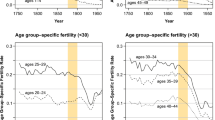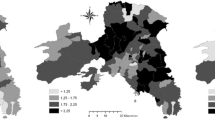Abstract
Substantial regional variation in marriage and fertility patterns continues to exist in Germany. Following a multilevel approach, we exploit longitudinal data from the German Family Panel (pairfam), enhanced by an array of district-level variables, to investigate the extent to which spatial variations in men’s and women’s family formation behaviors result from differences in population composition or from ‘true’ contextual effects. Our multilevel analyses provide evidence for only small—if any—contextual effects on individuals’ family formation behaviors (except for a continuation of significant differences between East and West Germany). However, we still find indication that (1) regional economic circumstances matter in determining individuals’ fertility intentions as well as their transition to first marriage, (2) regional milieus are associated with individuals’ fertility, and that (3) selective family migration takes place. While it seems that social interaction rather than differences in local opportunity structures plays a role here, more research is needed to further substantiate this conclusion.
Zusammenfassung
Bis heute lassen sich in Deutschland kleinräumig regionale Unterschiede im Heirats- und Geburtenverhalten feststellen. Einem Mehrebenen-Design folgend analysieren wir mit Kontextinformationen auf der Kreisebene angereicherte Längsschnittdaten des Beziehungs- und Familienpanels (pairfam), um zu untersuchen, inwieweit regionale Unterschiede im Familiengründungsverhalten von Männern und Frauen auf Bevölkerungskompositions- oder tatsächliche Kontexteffekte zurückzuführen sind. Die Ergebnisse unserer Mehrebenenanalyse zeigen – falls überhaupt – nur geringe Kontexteinflüsse auf individuelle Entscheidungen zur Familiengründung (außer nach wie vor bestehenden signifikanten Ost-West-Unterschieden). Dennoch finden sich Hinweise darauf, dass (1) regionale ökonomische Rahmenbedingungen relevant für Kinderwünsche und die Erstheiratswahrscheinlichkeit sind, dass es (2) einen Zusammenhang zwischen regionalen Milieus und Fertilitätsentscheidungen gibt, und dass (3) selektive Migration im Kontext der Familiengründung stattfindet. Der Schluss, dass soziale Interaktion bedeutsamer als Unterschiede in regionalen Opportunitätsstrukturen zu sein scheint, sollte jedoch durch zusätzliche Untersuchungen weiter substantiiert werden.
Similar content being viewed by others
Notes
Note that the individual-level control variables employed in our models—age, education and employment, parental and marital status, as well as information on whether the individual is a foreigner—are standard ones and will therefore not be discussed here any further.
Note that the full multilevel Poisson regression models for respondents’ number of children and for being childless (Table 1) did not converge. We thus estimated robust regressions, providing us with unbiased standard errors, but not the district-level variance component.
One reason why the interaction between the degree of urbanization and relocation between districts remained insignificant might be that family related relocations rather take place within a shorter geographical range (that is, between communities; see Kulu and Milewski 2007).
References
Andersson, Gunnar, Ann-Zofie Duvander, and Karsten Hank. 2004. Do child-care characteristics influence continued child bearing in Sweden? An investigation of the quantity, quality, and price dimension. Journal of European Social Policy 14:407–418.
Arránz Becker, Oliver, Daniel Lois, and Bernhard Nauck. 2010. Differences in fertility patterns between East and West German women. Comparative Population Studies—Zeitschrift für Bevölkerungswissenschaft 35:7–34.
Basten, Stuart, Johannes Huinink, and Sebastian Klüsener. 2011. Spatial variation of sub-national fertility trends in Austria, Germany and Switzerland. Comparative Population Studies—Zeitschrift für Bevölkerungswissenschaft 36:573–614.
Baumer, Eric P., and Scott J. South. 2001. Community effects on youth sexual activity. Journal of Marriage and Family 63:540–554.
Billy, John O. G., and David E. Moore. 1992. A multilevel analysis of marital and nonmarital fertility in the US. Social Forces 70:977–1011.
Brewster, Karen L. 1994. Neighborhood context and the transition to sexual activity among black women. Demography 31:603–614.
Brewster, Karen L., and Ronald R. Rindfuss. 2000. Fertility and women’s employment in industrialized nations. Annual Review of Sociology 26:271–296.
Buhr, Petra, and Anne-Kristin Kuhnt. 2012. Die kurzfristige Stabilität des Kinderwunsches von Kinderlosen in Ost- und Westdeutschland: eine Analyse mit den ersten beiden Wellen des deutschen Beziehungs- und Familienpanels. In Familie und Partnerschaft in Ost- und Westdeutschland. Ähnlich und doch immer noch anders (Supplement 9 to Zeitschrift für Familienforschung), eds. Johannes Huinink, Michaela Kreyenfeld, and Heike Trappe, 275–297. Leverkusen: Verlag Barbara Budrich.
Bundesinstitut für Bau-, Stadt- und Raumforschung (BBSR) (Ed.). 2012. Indikatoren und Karten zur Raum- und Stadtentwicklung (INKAR). Bonn: BBSR.
Cassens, Insa, Marc Luy, and Rembrandt Scholz, eds. 2009. Die Bevölkerung in Ost- und Westdeutschland. Wiesbaden: VS Verlag für Sozialwissenschaften.
Courgeau, Daniel, and Brigitte Baccaini. 1998. Multilevel analysis in the social sciences. Population (English Selection) 10:39–71.
Eckhard, Jan, and Thomas Klein. 2006. Männer, Kinderwunsch und generatives Verhalten. Eine Auswertung des Familiensurvey zu Geschlechterunterschieden in der Motivation zur Elternschaft. Wiesbaden: VS Verlag für Sozialwissenschaften.
Esser, Hartmut. 1988. Sozialökologische Stadtforschung und Mehr-Ebenen-Analyse. In Soziologische Stadtforschung (Supplement 29 to Kölner Zeitschrift für Soziologie und Sozialpsychologie), ed. Jürgen Friedrichs, 33–55. Opladen: Westdeutscher Verlag.
Fiori, Francesca, Elspeth Graham, and Zhiqiang Feng. 2014. Geographical variations in fertility and transition to second and third birth in Britain. Advances in Life Course Research 21:149–167.
Friedrichs, Jürgen, and Alexandra Nonnenmacher. 2014. Die Analyse sozialer Kontexte. In Soziale Kontexte und soziale Mechanismen (Supplement 66 to Kölner Zeitschrift für Soziologie und Sozialpsychologie), eds. Jürgen Friedrichs and Alexandra Nonnenmacher, 1–16. Wiesbaden: Springer VS.
Fulda, Barbara. 2014. Immer weniger Kinder? Soziale Milieus und regionale Unterschiede der Geburtenzahlen. PhD Dissertation: University of Cologne.
Gelman, Andrew, and Jennifer Hill. 2007. Data analysis using regression and multilevel/hierarchical models. Cambridge: Cambridge University Press.
Hank, Karsten. 2001. Regional fertility differences in Western Germany: An overview of the literature and recent descriptive findings. International Journal of Population Geography 7:243–257.
Hank, Karsten. 2002a. Regional social contexts and individual fertility decisions: A multilevel analysis of first and second births in Western Germany. European Journal of Population 18:281–299.
Hank, Karsten. 2002b. The geographic context of male nuptiality in Western Germany during the 1980s and 1990s. Demographic Research 7:523–536.
Hank, Karsten. 2003. Eine Mehrebenenanalyse regionaler Einflüsse auf die Familiengründung westdeutscher Frauen in den Jahren 1984 bis 1999. Kölner Zeitschrift für Soziologie und Sozialpsychologie 55:79–98.
Hank, Karsten, Michaela Kreyenfeld, and C. Katharina Spieß. 2004. Kinderbetreuung und Fertilität in Deutschland. Zeitschrift für Soziologie 33:228–244.
Hedman, Lina. 2014. Compositional or contextual effects? Neighbourhoods and teenage pregnancy in Stockholm, Sweden. In Soziale Kontexte und soziale Mechanismen (Supplement 66 to Kölner Zeitschrift für Soziologie und Sozialpsychologie), eds. Jürgen Friedrichs and Alexandra Nonnenmacher, 67–90. Wiesbaden: Springer VS.
Huinink, Johannes, and Michael Feldhaus. 2012. Fertility and commuting behaviour in Germany. Comparative Population Studies 37:491–516.
Huinink, Johannes, and Michael Wagner. 1989. Regionale Lebensbedingungen, Migration und Familiengründung. Kölner Zeitschrift für Soziologie und Sozialpsychologie 41:669–689.
Huinink, Johannes, Josef Brüderl, Bernhard Nauck, Sabine Walper, Laura Castiglioni, and Michael Feldhaus. 2011. Panel analysis of intimate relationships and family dynamics (pairfam): Conceptual framework and design. Zeitschrift für Familienforschung 23:77–100.
Huinink, Johannes, Michaela Kreyenfeld, and Heike Trappe, eds. 2012. Familie und Partnerschaft in Ost- und Westdeutschland. Ähnlich und doch immer noch anders (Supplement 9 to Zeitschrift für Familienforschung). Leverkusen: Verlag Barbara Budrich.
Huinink, Johannes, Torsten Schröder, and Mandy Boehnke. 2008. Kinderwunsch und Familiengründung: Die Bedeutung von Voraussetzungen und Entscheidungsgrundsätzen. In Neuere Entwicklungen in der Beziehungs- und Familienforschung. Vorstudien zum Beziehungs- und Familienentwicklungspanel (pairfam), eds. Michael Feldhaus and Johannes Huinink, 321–350. Würzburg: Ergon Verlag.
Jang, Bohyun Joy, John B. Casterline, and Anastasia R. Snyder. 2014. Migration and marriage: Modeling the joint process. Demographic Research 30:1339–1366.
Kopp, Johannes. 2000. Geburtenentwicklung in Ost- und Westdeutschland. In Solidarität, Lebensformen und regionale Entwicklung, eds. Hans Bertram, Bernhard Nauck, and Thomas Klein, 81–135. Opladen: Leske + Budrich.
Kravdal, Øystein. 2002. The impact of individual and aggregate unemployment on fertility in Norway. Demographic Research 6:263–294.
Kreyenfeld, Michaela, Johannes Huinink, Heike Trappe, and Rainer Walke. 2012. DemoDiff: A dataset for the study of family change in Eastern (and Western) Germany. Schmollers Jahrbuch 132:653–660.
Kulu, Hill. 2012. Spatial variation in divorce and separation: Compositional or contextual effects? Population, Space and Place 18:1–15.
Kulu, Hill. 2013. Why do fertility levels vary between urban and rural areas? Regional Studies 47:895–912.
Kulu, Hill, and Elizabeth Washbrook. 2014. Residential context, migration and fertility in a modern urban society. Advances in Life Course Research 21:168–182.
Kulu, Hill, and Nadja Milewski. 2007. Family change and migration in the life course: An introduction. Demographic Research 17:567–590.
Lazarsfeld, Paul F., and Herbert Menzel. 1969. On the relations between individual and collective properties. In A Sociological Reader on Complex Organisations, ed. Amitai Etzioni, 499–516. New York: Holt, Rinehart & Winston.
Lengerer, Andrea. 2001. Wo die Liebe hinfällt—ein Beitrag zur “Geographie” der Partnerwahl. In Partnerwahl und Heiratsmuster. Sozialstrukturelle Voraussetzungen der Liebe, ed. Thomas Klein, 133–162. Opladen: Leske + Budrich.
Lichter, Daniel T., F. B. LeClere, and D. K. McLaughlin. 1991. Local marriage markets and the marital behavior of black and white women. American Journal of Sociology 96:843–867.
Lloyd, Kim M., and Scott J. South. 1996. Contextual Influences on young men’s transition to first marriage. Social Forces 74:1097–1119.
Lois, Daniel, and Oliver Arránz Becker. 2014. Is fertility contagious? Using panel data to disentangle mechanisms of social network influences on fertility decisions. Advances in Life Course Research 21:123–134.
Lyngstad, Torkild H. 2011. Does community context have an important impact on divorce risk? A fixed-effects study of twenty Norwegian first-marriage cohorts. European Journal of Population 27:57–77.
Meggiolaro, Silvia. 2011. Do neighborhoods have an influence on reproductive intentions? Empirical evidence from Milan. Regional Studies 45:791–807.
Münch, Richard, and Neil J. Smelser. 1987. Relating the micro and macro. In The Micro-Macro Link, eds. Jeffrey Alexander, Bernhard Giesen, Richard Münch, and Neil J. Smelser, 356–388. Berkeley: University of California Press.
Myers, Scott M. 2010. Connecting the demographic dots: Geographic mobility and birth intentions. Journal of Family Issues 31:1622–1651.
Nauck, Bernhard, Josef Brüderl, Johannes Huinink, and Sabine Walper. 2014. Beziehungs- und Familienpanel (pairfam). GESIS Datenarchiv, Köln. ZA5678 Datenfile Version 5.0.0, doi:10.4232/pairfam.5678.5.0.0.
Rindfuss, Ronald R., David K. Guilkey, S. Philip Morgan, and Øystein Kravdal. 2010. Child-care availability and fertility in Norway. Population and Development Review 36:725–748.
Sobotka, Tomáš, Vegard Skirbekk, and Dimiter Philipov. 2011. Economic recession and fertility in the developed world. Population and Development Review 37:267–306.
South, Scott J., and Kyle D. Crowder. 2000. The declining significance of neighborhoods? Marital transitions in community context. Social Forces 78:1067–1099.
Stauder, Johannes. 2011. Regionale Ungleichheit auf dem Partnermarkt? Die makrostrukturellen Rahmenbedingungen der Partnerwahl in regionaler Perspektive. Soziale Welt 62:45–73.
Teachman, Jay D., and Kyle D. Crowder. 2002. Multilevel models in family research: Some conceptual and methodological issues. Journal of Marriage and Family 64:280–294.
Vidal, Sergi, Johannes Huinink and Michael Feldhaus. 2013. The effects of fertility intentions on short- and long-distance moves. Busan: XXVII IUSSP International Population Conference.
Wesolowski, Katharina. 2015. To have or not to have a child? Perceived constraints on childbearing in a lowest-low fertility context. Population, Space and Place21:86–101.
Acknowledgement
An earlier version of this article was presented at the 2014 PAA Annual Meeting in Boston. We would like to thank Hans-Peter Kohler for his discussion of our presentation. We are also grateful for comments by Michaela Kreyenfeld.
Author information
Authors and Affiliations
Corresponding author
Rights and permissions
About this article
Cite this article
Hank, K., Huinink, J. Regional Contexts and Family Formation: Evidence from the German Family Panel. Köln Z Soziol 67 (Suppl 1), 41–58 (2015). https://doi.org/10.1007/s11577-015-0322-9
Published:
Issue Date:
DOI: https://doi.org/10.1007/s11577-015-0322-9






